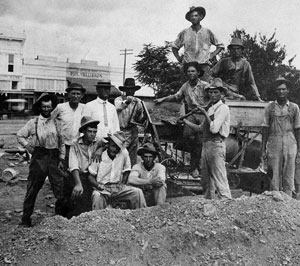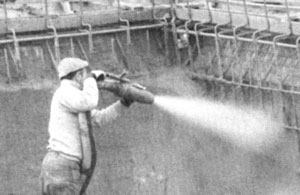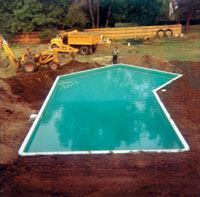A History of Pools and Spas: Timeline
TIMELINE
Each year brought new innovations, products and companies to the fold.
1887
First known public pool built in Brookline, Mass.
1890
Contractors combine concrete with reinforced steel for a stronger structure.
1895
One of America’s first home pools is built on a Vanderbilt estate in Asheville, N.C.
Early 1900s

Contractors use hand-cranked cement mixers.
1907
Dr. Carl Akeley invents the concrete gun to make life-size models of prehistoric animals.
Pre WW I Silent-movie star Francis X. Bushman is one of the first celebrities to have a pool installed on his estate.
1919

E.L. Wagner Co., of New York, begins building pools.
That same year, Illinois builder H.H. Enbody and his son Maurice build the first modern pool, made of steel-reinforced concrete.
Early-’20s

Pools are made of formed and poured concrete, with expansion joints.
At this time, pool starts in Southern California average about 20 per year.
1922

“Industry father” Pascal Paddock builds his first pool, for the city of Lancaster, Calif.
1924
Paddock starts Paddock Pools, mostly to build public pools; Lawrence A. Cline’s general contracting business begins building pools as well.
Late-’20s

Paddock begins using white plaster to finish and waterproof his pools.
Also in the late-1920s, Wesley Bintz begins building public pools in the Midwest.
Early-’30s
A man named Nightingale develops the first wet-niche pool light.
1932

The first Douglas fir diving board is made by S.R.Smith, LLC, in Canby, Ore.
1934
Paddock devises a method of pouring the entire pool shell as a monolithic structure, eliminating expansion joints.
1935
Chauncey Hyatt of the Illinois Health Department writes perhaps the first pool regulations, for the state’s 600 public pools.

Cline’s and Paddock’s firms incorporate. Paddock’s firm becomes known as Paddock Engineering Company Ltd.; Cline’s is L.A. Cline Inc.
1936

Southern California landscape architect Philip Ilsley, considered by some the father of the pool industry, begins incorporating pools into some of his new home backyards.
By 1938, Ilsley begins creating freeform pools, sometimes using boulders.
Later in the decade, he revolutionizes the industry with an oval-shaped pool with curved walls made of hand-packed, or dry-packed, concrete over steel.
1940

Ilsley builds first gunite pool in west Los Angeles.
That same year, Paddock sells his company to Ilsley.
1941-1945
World War II puts the industry on hold.
By 1945, soldiers, now trained to swim, come marching home to earning wives and the GI Bill.
1946

Anthony Pools opens.
By the late-’40s, Phil Anthony (shown) arranges the first bank financing for pools.
1948

Sylvan founder Herman Silverman builds his first pool, introducing hand-packed concrete pools to the Eastern pool industry.
Late-’40s

Kidney-shaped pools emerge.
Also by the end of the decade, Pascal Paddock invents the fiberglass pool, sold in four pieces.
Early-’50s
The Korean conflict stalls the industry yet again.
1952
California Pools & Spas forms.
1952-1957
First pool boom.
1954

Concrete-block, vinyl-lined pools emerge.
1958

Esther Williams, Elliott Keppler and Don Pruess start Esther Williams brand of concrete-block, vinyl-lined pools (left).

That same year, Cascade Pools sells wood-wall kit through Spiegel Catalog for $995 (right). Esther Williams also offers wood walls.
Late-’50s

The one-piece fiberglass pool debuts.
Early-’60s
The industry begins using PVC plumbing.

Also at this time, steel- and aluminum-wall pools appear (left).
In addition, increased tourism spurs the motel industry, which introduces more middle-class families to pools.
In this time of innovation, builders also being including loveseats, steps and spas on pools (left).

And, underwater lights developed with holes in the face ring allowing water to circulate within the face plate and keep the lightbulb cool (right)
1962
Kool deck hits the market, ushering in alternatives to concrete.
1963
A bankrupt Paddock Pools sells its assets to Albany, N.Y., franchisee William H. Baker and equipment manufacturer American Sanitary Mfg. of Abingdon, Ill.
1964

Estimates say package pools account for 16 percent of U.S. pool sales.
1965
New York and New Jersey suffer water shortage and first pool-filling ban.
Mid-’60s

Charles Wade of CHD Pool Equipment Inc. unveils a safety device: an electronic, ground-actuated circuit breaker.
Late-’60s

Inground spas take hold.

At this time, builders also begin including concrete collars on package pools.
And, package-pool manufacturers begin offering adjustable braces (shown), as well as alternatives to A-frame braces, such as X braces and K braces, to help support the surrounding deck.

Controllers hit the pool scene.
Mid-’70s

Multi-level projects with raised bond beams and raised spas become common.
1975

Polymer-wall package pools become available.
Early-’80s

Builders move away from standard pool shapes, offering more freeform options.
1982

Fiberoptic lighting becomes available for concrete pools.
1983

Lew Akins then of Ocean Quest Pool Inc. in Austin, Texas, helps popularize the vanishing-edge pool by building one.
1985

Meissner Mfg. Co. Inc. introduces Unicel — your single source for replacement filter elements.
1987

Pebble pool-interior technology imported from Australia. Other exposed-aggregate products follow.
Late-’80s
Computer-aided design emerges.
Early-’90s
Package pool coping outfitted with fiberoptic-lighting track came onto the scene.
1994

The first known vinyl-liner vanishing edge pool was built by Tommy Johnson of Johnson Pool & Construction Co. Inc. in Huntsville, Ala.
Mid-’90s

Fiberglass pools built with raised bond beams, spillover spas and vanishing edges are introduced.
1996

Vinyl fabricators introduce four-color printing, 3-dimensional-looking designs on liners.
Also that year, Sylvan Pools’ parent company, General Aquatics Inc., purchases Anthony Pools, creating Anthony/Sylvan, now owned by Essef Corp.

